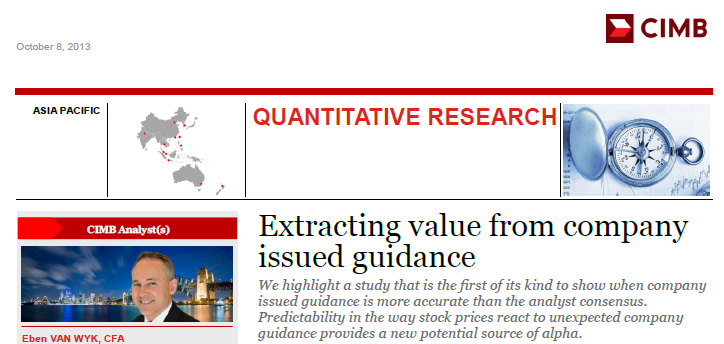
Recently, I posed a question on several different LinkedIn discussion groups. The question was worded somewhat differently for each group, in order to maintain an alignment with the group focus. But, essentially, all of the question asked “When is studying scientific research most useful for understanding financial markets?”
The respondents to these questions were generally accomplished financial professionals; and many meaningful discussions ensued. Positive suggestions were offered. Many individuals expressed excitement about digging more deeply into the empirical literature on financial markets. However, I found it fascinating to observe that there was also a distinct group of respondents who were highly skeptical of the entire scientific endeavor. Here is a sampling of some of their comments (I have used colored fonts to distinguish the different respondents):
Never. The future never resembles the past and persistence in performance for any length of time in the investment industry is almost unheard of.
I am surprised that you do not know that predicting financial markets can’t be done. It’s a “Fool’s Game”
“Never.”  …there is no useful research. The minute any useful research emerged (to the general public as suggested by the question), it would immediately be incorporated into financial markets, rendering that research no longer useful.
…there is no useful research. The minute any useful research emerged (to the general public as suggested by the question), it would immediately be incorporated into financial markets, rendering that research no longer useful.
Most of us, including myself, are all about data, but, as others have said, no empirical results – back, realtime or front, regardless of the power applied – can be the basis for long-term successful trading. Sadly, not even actual results can form such a basis – as actuals are indistinguishable from random.
Back testing is essential but most of the output is a curve fit illusion….Forward testing is of little use either; especially for longer term trading….I fear that studying scientific research is not a route to Eldorado. Investors should remember that at the end of the day, Candide gave up the attempt and resorted to peacefully cultivating his garden. Most would be traders would do well to do the same.
Building models incorporating genuinely objective data into a probability based decision chain is an interesting pursuit. However, no one knows what happens next particularly within any specified time slice. Seeking a useful predictive model producing near term efficacy is an exercise in futility.
Have financial markets been consistent enough (knowing all the parts of a valid research study that must be there in the research), amidst how quickly the world has changed in the last 200 years, to even get the kind of research that would still be valid today?
One can fiddle till doomsday with quantitative analyses of social reality, but since we are dealing with human creations and manipulations, I wouldn’t be inclined to believe very much in “scientific, empirical” research into financial markets.
Naturally, there are many ways of replying to such comments. Clearly, as the author of The Alpha Interface book series, I do have a vested interest in the scientific approach. On the other hand, as the former president (and still active participant) of the Intuition Network, I think that I have a more than healthy respect for non-scientific approaches. Here is a response that I recently posted to one of the LinkedIn lists.
You are doing an excellent job of articulating the limitations of the scientific approach to trading. It is interesting to me, however, to note that, for centuries, science has faced similar criticisms in virtually every discipline. And, at the same time, virtually every scientific discipline has experienced progress. Sometimes that progress is agonizingly slow. Sometimes it comes in fits and starts. But, I wouldn’t bet against it.
In my youth, I had a mentor named Arthur M. Young (see http://www.arthuryoung.com/ ) who was the inventor of the first commercially licensed helicopter (the Bell helicopter). Back in 1926, seeking to be an inventor, he visited the U.S. patent office hoping to find an unsolved technical problem. He learned that there were over 200 unsuccessful attempts to build a flying machine that could hover in mid-air. So, he set out to see if he could solve that problem.
For the first twelve years, he researched an approach that, ultimately led nowhere (propellers at the tips of the big rotor blades). Then, he hit upon the solution that ultimately worked. In 1947, the first production units rolled off the assembly line. (The Bell Model 47 was the small helicopter, with the glass bubble cockpit, and skids rather than landing wheels.)
One of his competitors, the Sikorsky company, used the emblem of the bumblebee on their aircraft. They had a slogan that was to the effect, “according to the laws of aerodynamics, the bumblebee cannot fly.”
One of the lessons I learned from Arthur M. Young was not to blindly accept conventional wisdom about certain things being impossible.
Most of us can point to, let us say, 200 failures (with regard to forward-testing, back-testing, risk-to-reward, accounts blowing up, funds collapsing, etc.) But, does that mean that science has hit a glass ceiling of sorts beyond which it cannot progress? I don’t think so.
It may mean, however, that many will decide to move in other directions….





